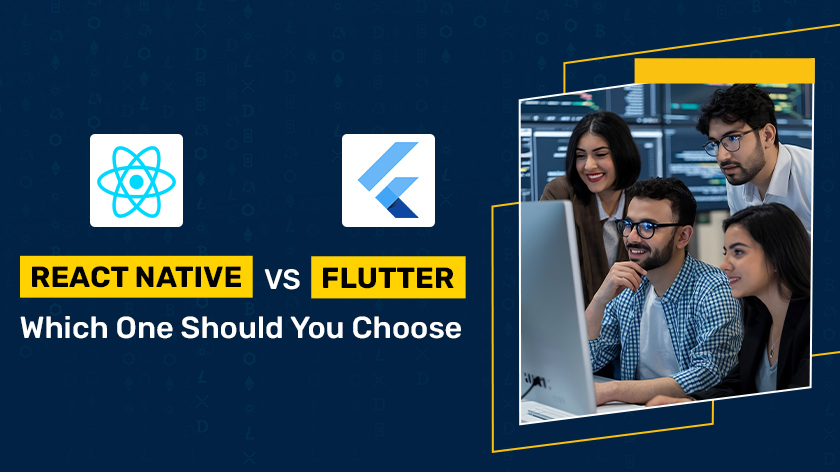When developing a cross-platform mobile application, choosing the right framework is crucial. React Native and Flutter are two of the most popular options, each offering unique advantages. But which one should you choose for your project? Let’s compare them based on key factors to help you make an informed decision. Understanding their advantages and constraints will help you make the most informed decision for your app development requirements.
What is React Native?
React Native, designed by Facebook, is a JavaScript framework that authorizes developers to establish mobile apps using React. It enables code reuse across iOS and Android, improving development speed and efficiency. With React Native, businesses can create apps with near-native performance while leveraging an extensive ecosystem of JavaScript tools and libraries.
Key Features of React Native
- JavaScript-Powered: Built on JavaScript, allowing web developers to smoothly transition into mobile app development.
- Hot Reloading: This enables developers to see changes instantly without rebuilding the app, significantly improving debugging and testing.
- Large Community Support: Extensive community and third-party libraries ensure continuous updates and vast learning resources.
- Native Modules: Enables integration with native code when needed, ensuring both flexibility and high performance.
What is Flutter?
Flutter, created by Google, is an open-source toolkit that uses the Dart programming language for UI development. It offers a comprehensive set of pre-designed widgets to create visually engaging applications. Unlike many other frameworks, Flutter renders UI components directly through its engine, ensuring high performance and a uniform appearance across platforms.
Key Features of Flutter
- Uses Dart: A modern, fast programming language optimized for UI development with a simple and expressive syntax.
- Hot Reload: Similar to React Native, allowing quick iteration and real-time UI updates without restarting the app.
- Customizable Widgets: Offers a rich set of pre-built and customizable widgets that adapt to different screen sizes and devices.
- High Performance: Uses its rendering engine (Skia) for smooth animations and transitions, reducing reliance on native components.
Comparing React Native and Flutter
1. Performance
Flutter generally provides better performance because it compiles native ARM code, whereas React Native relies on JavaScript bridges, which can slow down execution. Flutter’s direct compilation to machine code results in faster load times and smoother animations, making it an ideal choice for high-performance applications.
2. Development Speed
- React Native: Faster for developers familiar with JavaScript and React, as they can leverage existing knowledge and resources. Its component-based architecture also speeds up UI design and integration.
- Flutter: Requires learning Dart but provides a more streamlined UI development experience, thanks to its widget-driven approach and well-documented APIs.
3. UI & Design
- React Native: Leverages native components for an OS-consistent look but may need extra effort for cross-platform design alignment.
- Flutter: Uses custom widgets for greater UI flexibility, enabling highly tailored designs, though they may not always match native aesthetics.
4. Community & Ecosystem
- React Native: Boasts a vast developer community and a wide range of third-party libraries, providing ongoing enhancements and integration support.
- Flutter: Growing rapidly, with increasing adoption and support from Google, making it a strong contender for future development trends.
5. Stability & Maintenance
- React Native: Well-established with long-term support and a vast library of plugins, making it a reliable choice for many projects.
- Flutter: Relatively newer but gaining significant backing from Google, with frequent updates and enhancements that improve performance and usability.
When to Choose React Native?
- If you need a larger ecosystem with third-party integrations, providing quicker access to plugins and APIs.
- If you need a larger ecosystem with third-party integrations, providing quicker access to plugins and APIs.
- If you require quick development with reusable web and mobile code, ensuring cost-effective solutions and rapid deployment.
When to Choose Flutter?
- If you want superior performance and a consistent UI across platforms, reducing compatibility issues and ensuring a unified experience.
- If your project involves complex animations and graphics, as Flutter’s rendering engine provides smoother performance.
- If you’re building an app from scratch and want Google’s latest technology, ensuring long-term scalability and innovation.
Conclusion
Both React Native and Flutter offer powerful tools for cross-platform development. The choice depends on your team’s expertise, project requirements, and performance needs. React Native is great for JavaScript developers and quick deployment, while Flutter is ideal for high-performance and visually rich applications. Evaluating your project scope, budget, and timeline will help you make the best decision.
Looking for expert guidance on choosing the right mobile app framework? Xceltec can help you build a scalable, high-performance app tailored to your needs. Contact us today to kickstart your project with the best technology stack!
For More Information, Visit Our Website: https://www.xceltec.com/
 :
https://in.pinterest.com/xceltec0192/
:
https://in.pinterest.com/xceltec0192/












